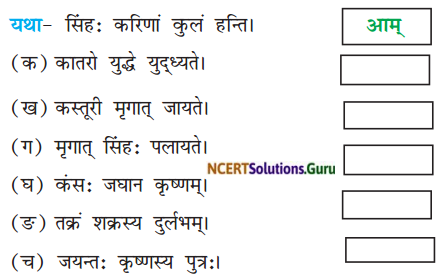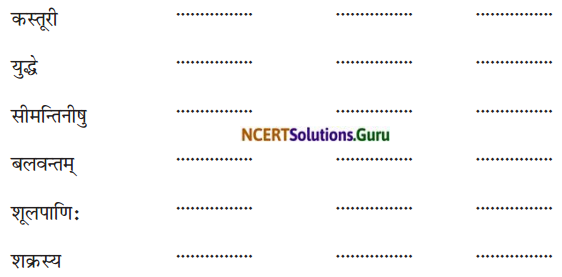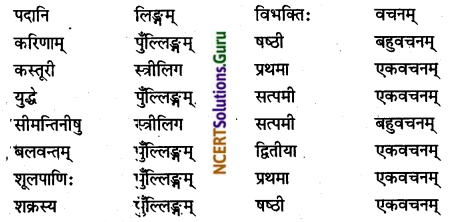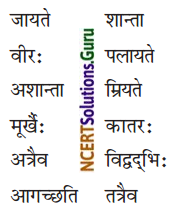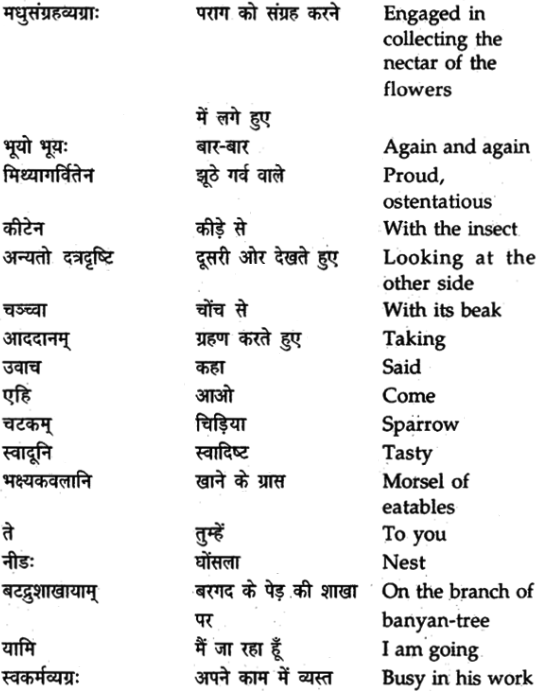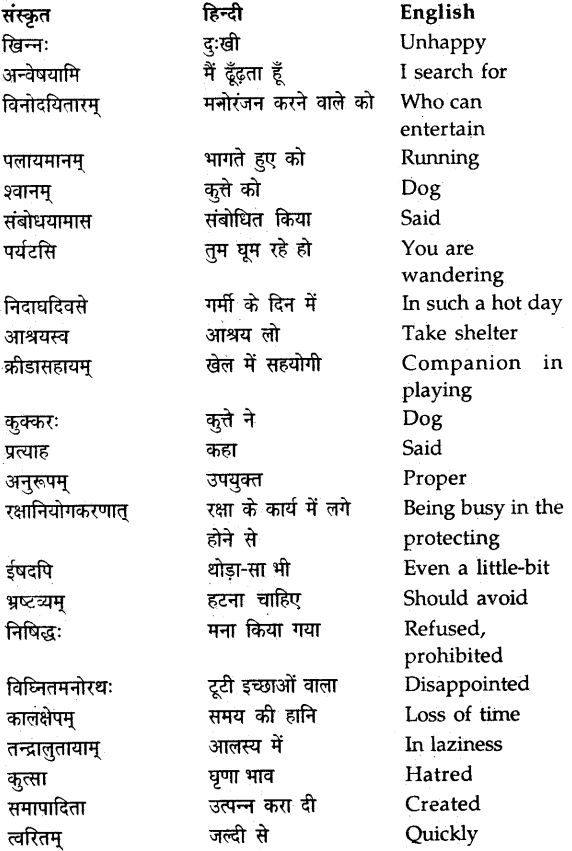Detailed, Step-by-Step NCERT Solutions for 12 Business Studies Chapter 5 Organising Questions and Answers were solved by Expert Teachers as per NCERT (CBSE) Book guidelines covering each topic in chapter to ensure complete preparation.
Organising NCERT Solutions for Class 12 Business Studies Chapter 5
Organising Questions and Answers Class 12 Business Studies Chapter 5
Multiple Choice Questions
Question 1.
Which of the following is not an element of delegation?
(a) Accountability
(b) Authority
(c) Responsibility
(d) Informal organisation
Answer:
(d) Informal organisation
Question 2.
A network of social-relationship that arise spontaneously due to interaction at work is called ……….
(a) Formal organisation
(b) Informal organisation
(c) Decentralisation
(d) Delegation
Answer:
Informal organization.

Question 3.
Which of the following does not follow the scalar chain?
(a) Functional structure
(b) Divisional structure
(c) Formal organisation
(d) Informal organisation
Answer:
(d) Informal organisation
Question 4.
A tall structure has a ……….
(a) Narrow span of management
(b) Wide span of management
(c) No span of management
(d) Less levels of management
Answer:
(b) Wide span of management
Question 5.
Centralisation refers to ……….
(a) Retention of decision making authority
(b) Dispersal of decision making authority
(c) Creating decisions as profit centers
(d) Opening new centers or branches
Answer:
(a) Retention of decision making authority
Question 6.
For delegation to be effective it is essential that responsibility be accompanied with necessary
(a) Authority
(b) Manpower
(c) Incentives
(d) Promotions
Answer:
Authority.

Question 7.
Span of management refers to ……….
(a) Number of managers
(b) Length of term for which a manager is appointed
(c) Number of subordinates under a superior
(d) Number of members in top management
Answer:
(c) Number of subordinates under a superior
Question 8.
The form of organisation known forgiving rise to rumors is called ……….
(a) Centralised organisation
(b) Decentralised organisation
(c) Informal organisation
(d) Formal organisation
Answer:
(d) Formal organisation
Question 9.
Grouping of activities on the. basis of product lines is a part of …………..
(a) Delegated organisation
(b) Divisional organisation
(c) Functional organisation
(d) Autonomous organisation
Answer:
(b) Divisional organisation
Question 10.
Grouping of activities on the basis of functions is a part of …………..
(a) Decentralised organisation
(b) Divisional organisation
(c) Functional organisation
(d) Centralised organisation
Answer:
(c) Functional organisation
Short Answer Type Questions
Question 1.
Define organisation?
Answer:
“Organisation is the form of every human association for the attainment of a common purpose” – James D. Monney
“Take away our factories, our trade, our avenues of transportation our money, leave nothing but our organisation, and in four years we shall have re-established ourselves” – Andrew Carnegie
When ever and wherever some people work together it is natural for the problems to arise. Some of these problems related to the organisation like how to divide the work, what should be allocated . to whom, what shall be the rights and responsibilities of different people, how shall the work of different people be Co-ordinated etc.

If proper solutions to these problems are not found, it is quite possible that some of the activities shall be repeated while some others shall be completely omitted. It will result in unnecessary delay and wastage of money. Hence, it is necessary that the work is entrusted to individuals according to their abilities, they are given adequate authority and their responsibilities are properly determined so that necessary action can be taken against them in case of delay in completion of activities. Carrying out all these activities is known as organising.
An organisation in which the resources of production are properly organised faces no problem in the achievement.of its per-determined objectives. According to C. Kenneth, ” A sound organisation is the answer to every business problem, that a poor organisation could run a good product into the ground and that a good organisation with a poor product could run a good product out of the market”
(a) Some Authors Consider it a Comprehensive Activity
(1) According to Henri Fayol, “To organise a business is to provide it with everything useful to its functioning, raw materials, tools, capital and personnel.” Fayol believes that the most important function of management is that it procures and organises various physical and human resources. But now a days the work organisation is being used in some special context.
(b) Organisation : As a Group Concept
(2) According to Me. Farland, “An identifiable group of people contributing their efforts towards the attainment of goals is called organisation.”
(3) According to R.C. Davis, “Organisation is a group of people who are co-operating under the direction of leadership for the accomplishment of a common end.”
(4) According to Chester Bernard, “An organisation comes into existence when there are a number of persons in communication and relationship to each other and are willing’to contribute towards a common endeavour”.
According to Bernard, “Organisaton as a group, has .three characteristics
- Communication
- Co-operative efforts
- Common objectives.
Every organisation has some pre-determined objectives. These objectives are common and it is for the attainment of these objectives that an organisation comes into existence. Individuals work in an organisation^ they share ideas with another and work together for the achievement of common objectives.

(c) Organisation : As a Process of Dividing the Activity into Various Units :-
(5) According to Urwick, “Organisation is the determining of activities which are necessary to any purpose and arranging them in groups which are assigned to individuals.”
(6) According to Northcott, “Organisation is an arrangement by which tasks are assigned to people so that their individuals efforts contribute effectively to some more or less clearly defined purpose for which they have been brought together.”
(d) Organisation : As a Process of Co-ordination
(7) According to G.E. Millward, “Harmonious relationship of work and workmen is called organisation.
(8) According to William R. Spriegal, “In its broadest sense, organisation is an art where in necessary principles are applied to control three M’s i.e. men, machinery and material in an enterprise.”
(9) According to Harolad Knnotz and O’ Donnell, “Organising v- involves the grouping of activities necessary to accomplish goals and plans, the assignment of these activities to appropriate departments and the provision for authority delegation and co-ordination.”
Thus from the study of above definitions it is clear that while on one hand organisation creates co-ordination between various activities and functions, on the other hand it is an art of establishing harmonious relationships among different individuals so that there is an effective and uninterrupted communication among them.
Question 2.
What are the steps in the process of organizing?
Answer:
Essential steps or Elements of Organisation Process :-
Various scholars have laid down various elements of the organisation process. Hodge and Johnson have laid down following elements of organization
- Objectives
- Group membership
- Proper division of work
- Physical resources and
- Policies and procedures.
Chester Bernard has laid down following elements of organisation:
- Communication
- Co-operation and willingness to serve
- Common objectives
Koontz and O’Donnell has included following steps in the process of organisation –
- Determination of the objectives of the organisation.
- To lay down the strategies, policies and plans
- To determine the activities for the achievement of objective.
- To identify various activities and categorise them.
- To group the activities.
- To provide authority to the group to perform activities through the medium of their head.
- To review the work done by such groups and see whether they are being performed according to the predetermined plans or no.

To summarise, the process of organisation includes following elements, activities or steps. They are also known as various stages of forming an organisation
(1) Division of Labour : Every person should be handed over work according to his abilities by resorting to division of labour. On the basis of the principles of division of every group is handed over some specified work. This leads to increase in the efficiency of the efforts of such group. Division of labour or specialisation leads to increase in the work efficiency. Departmentation is also done on the same principle.
(2) Sources of Authority : It has to be determined that who will take orders from whom and whom shall he give orders to. As authority gives rise to responsibility hence fixing of responsibility is essential while delegating auhtority to people working at different levels of the organisation.
(3) Establishment of Relationships : It is essential to establish relationships between individuals working at all levels of management. The relationships must be established in such a way that there is smooth and uninterrupted functioning of the communication system between various levels of organisation.
(4) Objectives of Organisation : The objectives of the organisation should be clear to everyone working in it. Such objectives affect the structure of organisation ; because the structure is merely a medium to achieve them. Objectives must be easily achievable.
(5) Structural side of Organisation : While structuring the organisation it must be kept in mind that the organisation structure is long living and it is not possible to bring about frequent changes in it. The limits of the authorities of different individuals, state of specialisation and capabilities of the individuals must be considered while determining the structure of the organisation.
(6) Selection of Efficient Employees : The success of any organisation depends upon the efficiency of its employees’. Efficient employees can bring about an improvement in a bad organisation and inefficient employees can ruin even a good organisation.
(7) Go-ordination : Division of labour leads to the division of the organisation into various departments, activities and units, thus it leads to the requirement of keeping proper co-ordination between them. The managers must ensure that the activities of an individual contribute to that of the other rather than creating an obstacle for him. It is the harmonious relations (among groups of people in the organisation which transform business houses into business homes where people love to work together.
Question 3.
Discuss the elements of delegation?
Answer:
Definitions of Delegation
Different scholars have given different definitions of delegation. Some of the important ones frofn them are
(1) According to Prof. Theo Haimann, “Delegation of authority merely means the granting of authority to subordinates to operate within prescribed limits.”
Elements of Delegation or Process of Delegation. According to William Newman three elements are included in the process of delegation .
- Assignment of Duty or Task.
- Granting of Authority.
- Creation of Obligation or Accountability.
(1) Assignment of Duty or Task : No manager can himself perform all the work of the organisation. He has therefore to assign a part of his duties to others. For this, the managers divides the total work and decides which work is to be performed by him and which work can be easily assigned to the subordinates.
Usually those tasks which are of utmost importance and which he alone can perform because of his unique plancement in the organisation are kept by the manager with him and all other tasks are assigned to his subordinates. For example, if an organisation has one head office and many branches then in such situation the superior will look after the head office and will hand over the responsibility of the branches to the subordinates.
(2) Granting of Authority : Authority is the key to all managerial activities. The subordinates are given authorities in accordance with the type and volume of the task assigned to them. Unless subordinates are given adequate authority it will not be possible for them to discharge their duties effectively.
In fact, the top executives shall give such authority to his subordinate which shall be required by himself to complete such job. For example, when a person is assigned the responsibility of managing a branch, he shall also be given the authority to divide the work among the staff, to make sale-purchase of goods and to spend money.

(3) Creation of Obligation or Accountability : The third important element in the process of delegation is to create obligation for the satisfactory performance of the work assigned to him. In the words of Alien, Accountability is the obligation to carry out responsibility and exercise authority in terms of performance standards established”.
The subordinates are answerable to their superiors for the success or failure of their endeavours. No other person, no matter how important he is, can demand an answer from the subordinate. The success of delegation lies in the fact that the subordinate accomplishes the task assigned to him according to the orders and control of the delegator. And if the work is not done according to the orders of the delegator, he must have full rights to ask for an explanation.
Another important point about accountability is that the managers is not discharged of his accountability merely by delegating his authority to subordinates. Thus, if ‘x’ delegates some authority to ‘y’ is accountable to ‘x’ for the work performed by him and at the same time ‘x’ is responsible and accountable to his superiors for the negligence and mistake committed by ‘y’. Thus, final accountability will remain with the superior despite delegation. In other words, we can say that “Only Authority can be delegated and not the accountability.”
Question 4.
What does the term “Span of management” refer to?
Answer:
The concept of span of management or span of control, the corner-stone concept of classicists, refers to the number of subordinates that a superior can supervise effectively. This idea is central to formal organization theory because traditional principles greatly emphasize co-ordination exercises through the superior at the top. Consequently much interest and attention has focused on the number of people a superior can effectively supervise. The question as to how many people can a manager;supervise effectively has long plagued managers.
Yet little progress has been made in giving a satisfactory reply to this apparently simple question. Research has not produced a magic number either. The problem is still with us.
What is SPAN?
The principles of span of management is a statement of the limitation of the number of people or activities that a manager can effectively manage. It states that no single executive should have mce people looking to him for guidance and leadership than he can reasonably be expected to serve.
To overcome the biological limitations, every manager has to delegate work to as many subordinates as he can effectively manage. Thus, span of management is the reason for departmentation and delegation of authority. One important thing should be noted in the definition cited above. ‘It is not how many people report to a manager that matters. It is how many people who have to work with each other report to a manager. What counts is the number of relationships rather than the number of men.’
Question 5.
Under what circumstances would functional structure prove to be an appropriate choice?
Answer:
Functional structure is most suitable when the size of the organization is large, has a diversified activities and operations require a high degree of specialization.
In any scheme of functional organization of the activities, the following points need to be noted carefully
(a) Provision for all activities Work allocation among different departments should cover all the activities. For each activity there should be one or the other department to perform it.
(b) Duplication to be avoided While work allocation should cover all activities, care should be taken tp see that the same activity is not handled by two different departments or persons.
(c) Activities to be inter-related Activities places under the charge, of a department should be interrelated. At least, they should not be different from one another as Industrial engineering and market research, or production planning and advertisement.
To make a success of functional structure it should be practised only at higher levels. If practised at lower levels, it may create too many cross,-relationships, in which case it may become difficult to determine who has authority over whom, who is responsible to whom, and what work each one is supposed to do.
Functional structure promotes logical division of work and leads to specialization at every work point. With each activity being in charge of a number of specialists, there is not much need to have well-trained line executives at each work point.

Question 6.
Draw a diagram depicting a divisional structure.
Answer:
Divisional structure: Many large organizations with diversified activities have reorganized themselves away from the simpler and basic functional structure towards a divisional structure which is more suited to their activities. This is particularly true to those enterprises which have more than one category of products to offer.
This is because although every organisation performs a set of homogenous functions, as it diversifies into varied product categories, the need for a more evolved structural design is felt to cope with the emerging greater complexity. In a divisional structure, the organisation structure comprises of separate business units or divisions. Each unit has a divisional manager responsible for performance arid who has authority over the unit.
Generally, manpower is grouped on the basis of different products manufactured. Each division is multifunctional because within each division function like production, marketing finance, purchase etc. are performed together to achieve a common goal. Each division is self contained as it develops expertise in all functions related to a product line.
In other words, within each division, the functional , structure tends to be adopted. However, functions may vary across 1 divisions in accordance with a particular product line. Further, each division works as a profit center where the divisional head is responsible for the profit or loss of his, division.
For example, a large company may have divisions like cosmetics, clothing etc.
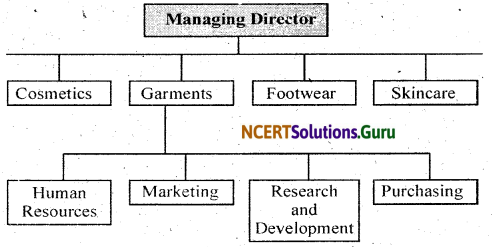
Question 7.
Can a large sized organization be totally centralized or decentralized? Give your opinion.
Answer:
An organization can never be completely centralized or decentralized. As it grows in size and complexity, there is tendency to move towards decentralized decision making. This is because in large organizaton those employees,who are directly and closely involved in certain operations tend to have more knowledge about their own than the top management which may only be indirectly associated with individual operation. Decentralization has more benefits to large-sized organization which may be defined as under –

Advantages of Decentralisation
Now a days, all the big organisations resorts to decentralisation in order to find a solution to all their complex problems. The various benefits of decentralisation are as follows :-
(1) Reduction in the Burden to Top Executives : In a decentralised set-up, the authority to make most of the decisions is entrusted to the middle and lower level management thus reducing the burden on top level managers. Decentralisation relieves the pressure on the top executives and provides them time to think and make better plans for the future.
(2) Source of availability of capable managers :
Decentralisation provides an opportunity to lower level executives to make independent decisions. This helps them to gain more and more proficiency and experience. They are automatically trained to take up larger assignments, handle bigger departments and promoted to higher posts. This acts as an important internal source of qualified and experienced manpower for higher positions.
(3) Improvement in morale : Opportunity to make independent decisions improves the job satisfaction, motivation and morale of subordinate managers. It satisfies their needs for power, prestige, status and independence.
(4) Improvement in Industrial Relations : Under decentralisation the authority to take decisions is given to the lower level managers who are well acquainted with the problems of the staff working under them. They consult their staff before taking any decision and do not take decisions which will make them unhappy. This ensures better cordial relations among the staff and managers.
(5) Encouragement to Initiative and Innovation : The subordinates do not try to solve the problems of their departments if they are not given adequate authority to solve them. But under decentralisation all departmental heads and section incharge” independently handle their respective areas of operations and have a free hand from seniors. As a result they initiate new schemes which increases the efficiency of their departments.
(6) Quick and Best Decisions
Under decentralisation lower level executives need not consult their superiors while making decisions. They are fully authorized take decisions without any interference of their superiors. Hence the decisions can be taken very quickly. Not only this/the decisions are more accurate also, because they are made by those who are fully aware of the realities of the situation.
(7) Safety of the markets : If an enterprise operates in large number of markets, its chief executive cannot handle all of them since every market will,have different sets of problems. Under decentralisation aseparate manager is appointed for each area of operation and they are given wide authority so that they can understand and solve the problem of that area. Thus benefits of local conditions can also be fully availed of.
(8) Sufficient importance to each partner : If any organisation produces and sells a number of products, a single manager cannot pay adequate attention to the size, design and price of each product. Hence, through decentralisation managers so that adequate attention can be given to each and every product.
(9) Fixation of Responsibilities : Under decentralisation the whole organisation is divided into different independent units and the manager of each unit is given adequate authority to take decisions to make his unit successful. The profits and losses of each unit are ascertained separately which helps in the fixation of Responsibility of each manager.
(10) Identification of Efficient and Inefficient Managers : Under decentralisation each and every manager has full authority to make independent decisions for his work area. Thus the success or failure of his decisions become a way of measuring his efficiency. The inefficient managers can thus be easily identified.
(11) Full Advantages of Local Conditions : Decentralised units operating in various regions and states can take full advantage of its local conditions.
(12) Improvement in communication
Decentralisatin improves communication because there are fewer levels of authority. The problem of red-tapism and bureaucratic delays are reduced to the minimum.
While studying the America’s General Motor Company, Peter Drucker has mentioned following advantages of decentralisation
(i) Decisions are quick and without any confusion.
(ii) There are less chances of conflicts between top level managers and departmental managers.
(iii) Subordinates have fiill confidence of receiving rewards for their good work.
(iv) Policies are not able to affect the organisation.
(v) There is development of informality and democracy in management.
(vi) There is abundance of qualified personnel in the organisation itself to be promoted to senior positions.
(vii) The gap between seniors and subordinates comes to an end.
(viii) The inefficient managers are identified and mutualcompetition between different departments brings forth the weakness of each department which can be easily removed.
(ix) Executives are aware of all facts while taking decisions.
(x) Supervision becomes effective.
Question 8.
Decentralisation is extending delegation to the lowest level. Comment.
Answer:
Decentralization
Decentralization is the systematic effort to delegate to the lowest levels, all authority except that which can be exercised at central points. It is the pushing down of authority and power of decision-making to the lower levels. Decentralization, in recent years, has come to be accepted as a golden calf of management philosophy.

It has come to be associated as a fundamental principle of democratic management where each individual is respected for his inhearent worth, and constitution. As pointed out earlier, absolute centralization (where there is no room for subordinates) or absolute decentralization (where there is no co-ordinated, organized activity) is’ fictitious in practice, it is a matter of degree along a continuum. Generally, speaking, decentralization is said to be greater :
- When more decisions are made at lower levels.
- When more important decisions are made at lower levels.
- When more functions are affected by decisions made at lower levels.
- When the checking on the decisions made at lower levels in minimal.
Long Answer Type Questions
Question 1.
Why Is delegation considered essential for effective organizing?
Answer:
Advantages of Delegation : Delegation is an indispensable component of good organisation. It is essential to the existence of a formal organization. It is one of the ‘mainspring of effective management.’ According to Koontz and O’Donnell, just as authority is key to organization, the primary purpose of delegation is to make organisation possible.
It is also claimed that ‘effective management is management through delegation’ only. These statements stretch the virtues of delegation to a point where we may be forced to believe that without delegation effective action is impossible. These can be proved through following points
(1) Superior Related Advantages
The essence of delegation process is empowering another person to act for the manager. There are certain practical reasons for this managerial preference
- To reduce the burden of responsibility carried by him.
- To provide more time for constructive review, or deliberation in the interests of progress.
- To enable selected activities or services to be more expertly covered and provided.
- To provide for the extension of facilities by the establishment of local centres in different areas.
Instead of carrying a full briefcase of provisions home dai ly and bury himself in endless routine, the manager, through delegation, would be better off sharing his ever-increasing workload with others and concentrate on important issues. Delegation frees top management from operational responsibilities. It helps the managers to distribute their load of work to others and thus multiply their limited personal capacities.
(2) Subordinate Related Advantages : Delegation has a ‘tonic effect’ on the psychology of subordinates. It allows subordinates to grow, enlarge their understanding and develop their capacities. It causes subordinates to accept responsibility and exercise judgement. It raises the subordinates positions in status and importance. It is delegation of authority that gives subordinates the means with which to act and learn.
(3) Improves Behavioural Climate : Authority centralization may be highly fascinating to authoritarian leaders. Such leaders believe in making decisions themselves, giving detailed instructions to their subordinates and exercise control from close quarters. Consequently, they over-burden themselves to the extent that they never find enough time to concentrate on their own responsibilities of planning, organization and controlling.
The subordinates, in turn, may return to obey rules ruler and regulation continuously, their morale will be low and performance may be mediocre. Delegation implies freedom of action sufficient to get the work done. It means freedom to make decisions, to commit mistakes and use one’s capacities fully.
Without giving the necessary amount of freedom, it may be virtually impossible to rally men and women toward a common purpose. Delegation, thus, improves the behavioural climate in the organization and paves the way for improved job satisfaction and productivity.
(4) Advantages to organization : At the extreme, if there is no delegation, one person has to do everything and hence, there would be no organisation. But for delegation firms would remain small and an increase in their size would burn up the candle of managerial energies too soon. The primary purpose of delegation, as pointed out earlier, is to make organization possible.
Delegation leads to better decisions, since subordinates closer to the ‘firing line’ are likely to have a clearer and more complete view of the facts. In addition, effective delegation speeds up decisions- making in an organization. Instead of waiting at the door-steps of the superior for an audience for a painfully long time, the subordinates can now take decisions independently.

Question 2.
What is a divisional structure? Discuss its advantages and limitations.
Answer:
In a divisional structure, the organization structure comprises of separate units or divisions. Each division has one divisional manager responsible for performance and who has authority over the unit or division. Each division is multifunctional because within each division functions like production, marketing, finance, purchase etc. are performed together to achieve a common goal. Each division is self- contained as it develops expertise in all functions related to product line and separate functional structure tends to be adopted.
Advantage of Divisional structure
The divisional structure offers many benefits. Prominent among these are as follows.
(1) Product-specialization helps in the development of varied skills in divisional head and this prepares him for higher positions. This is because he gains experience in all functions related to a particular product.
(2) Divisional heads are accoutable for profits, as revenues and costs related to different departments can be easily identified and assigned to them and this provides a proper basis for perfomance measurement. It also helps in fixation of the top division and appropriate remedial action can be taken.
(3) It promotes flexibility and initiative because each division functions an autonomous unit which leads to faster decision making.
(4) It facilitates expansion and growth as new divisions can be added without interrupting the existing operations by merely adding another divisional head and staff for the new product line.
Disadvantages of Divisional structure :
The divisional structure has certain dis advantages, some of them are as follows.
(1) Conflict may arise among different divisions with reference to allocation of funds and further a particular division may seek to maximize its profits at the cost of other divisions.
(2) It may lead to increse in costs since there may be a duplication of activities across products. Providing each division with separate set of similar function increase expenditure.
(3) It provides managers with the authority to supervise all activities related to a particular division. In course of time, such a manager may gain power and in a bid to assert his independence may ignore organizational interests.
Question 3.
Decentralization is an optional policy. Explain why an organization would choose to be decentralized.
Answer:
Decentralisation implies the dispersal of decision-making power at lower levels of management. When the power to take decisions and formulate policies does not lie with one person at the top but it is passed on to different persons at various levels, it will be a case of decentralisation.
The decisions taken at lower level should not only be more in number but they should be important also. If insignificant – decisions are allowed to be taken at lower levels then it will not be a case of decentralisation.
Definitions
Me Farland “Decentralisation is a situation in which ultimate authority to command and ultimate responsibility for results in localised as far down in the organisation.
Keith Davis “Decentralisation is wide distribution of authority and responsibility to the smallest unit, that is practical throughout the organisation.
Louis A. Allen “Decentralisation refers to the systematic effort to delegate to the lowest levels all authority, except that, which can only be exercised at central points.
Decentralization is an optional policy as it reduces the burden of the top management enabling them to concentrate on more important matters. It gives birth to more freedom of action because once the authority is distributed systematically there will be periodic appraisal and not the continuous supervision.
An organisation to choose decentralization due to various advantages attached to the concept, which may be discussed as under:-
(1) Relief to Top executives : Decentralisation helps to reduce the workload of top executives. They can devote greater time and attention to important policy matters by decentralizing authority for routine operational decisions.
(2) Prompt Decisions : Decentralization brings the decision-making process closer to the point of action. Decisions are made by those who are fully aware of the actual position. This leads to prompt and better decisions.
(3) Facilitates Growth and modifications : With growth and modifications of activities, an organization grows complex and poses a challange to the top executives. Decentralization helps in meeting this challenge effectively. Decentralization treats each product line as a separate decision so that it can respond quickly to the changing demands of its special market. Thus, a decentralized setup is more suitable for growing and changing enterprises.
(4) Improve Motivation : Passing of authority at middle and lower level shows that the trust and faith of top level in their subordinate and this trust and faith motivate the employee working at different levels as they are allowed to take decisions without seeking the approval of superiors.
(5) Managerial Development : Decentralization creates a work environment where there is freedom to make decisions, freedom to take initiative and freedom to act. Subordinates learn to manage by using delegates authority. Thus, decentralization provides a fertile base for the training and development of subordinates.
(6) Promotes Competition : Under decentralized set-up, each department is a separate profit- centre. The employees concept with each other to improve performance of their respective departments. This sense of, competition helps in improving the performance of all the departments which improve the overall performance of the organization.
(7) Better control and superivison : Decentralization ensures better control and supervision as the subordinates at the lower level will have the authority to make independent decisions. As a result they have through knowledge of every assignment under their control and care in a position to make amendments and take corrective action.
(8) Improved Industrial Relations : In a Decentralized organisation employees have greater opportunities to came in close contact with each other. This close relationship helps in understanding each other’s problems and solving these problems together. ‘As, the lower level managers have a direct- contact with their subordinates, it helps them in understanding their subordinates problems and solving their together. Thus decentralisation helps to establishing good industrial relations.
(9) Effective communication : Under decentralisation, the span of management is wider and there are fewer levels of organisation. Therefore communication system becomes more effective. Intimate relationships between superiors and subordinates can be developed.

Question 4.
How does informal organization support the formal organization?
Answer:
Informal organization : Interaction among people at work gives rise to a ’network of social relationships among employees’ called the informal organisation. An informal organisation is an aggregate of interpersonal relationships witout any conscious purpose but which may be contribute to joint results – Chester Barnand
Informal organisation is a network of personal and social relations not established or required by the formal organization but arising spontaneously as people associate with one another. – Keith Davis
Informal organization emerges from within the formal organisation when people interact beyond their officially defined roles. When people have frequent contacts they cannot be forced into a rigid formal structure. Rather, based on their interaction and friendship they tend to form groups which show conformity in terms of interest.
Examples of such groups formed with common interest may be those who take part in cricket matches on Sundays, meet in the cafeteria for coffee, are interested in dramatics etc. Informal organization has no written rules, is fluid in form and scope and does not have fixed lines of communication.
Main features
(1) An informal organisation originates from within the formal organisation as a result of personal interaction among employees.
(2) The standards of behaviour evolve from group norms rather than officially laid down rules and regulations.
(3) Independent channels of communication without specified direction of flow of information are developed by group members.
(4) It emerges spontaneously and is not deliberately created by the management.
(5) It has no definite structure or form because it is a complex network of social relationship among members.
Advantages
The informal organisation offers many benefits. Important among them are given below
(1) Prescribed lines of communication are not followed. Thus the informal organisation lead to faster spread of information as well as quick feedback.
(2) It helps to fulfill the social needs of the members and allows them to find like minded people. This enhances their job satisfaction since it gives them a sense of belongingness in the organisation.
(3) It contributes towards fulfillment of organizational objectives by compensating for inadequacies in the formal organization. For example, employees.reactions towards plans and policies can be tested through the informal’network.
Question 5.
Distinguish between centralization and decent
Answer:
| Basis |
Centralisation |
Decentralisation |
| (1) Meaning |
It refers to concentrate of authority at top level. |
It refers to the systematic despersal of authority at all levels of management and in all departments of organisation. |
| (2) Authority of Top Management |
Top management retains absolute authority for making almost all decisions on the functioning of organisation. |
Top management retains authority for making major decisions and forming major policies and for overall control and coordination of the organisation. |
| (3) Authority of middle and lower level management |
Middle and lower level management is not entrusted with operational authority for taking decisions on the tasks assigned to them. |
Middle and lower level management is entrusted with operational authority for taking decisions on the tasks assigned to them. |
| (4) Freedom of action |
Manager have less freedom of action since they are kept under close supervision by their supervisor. |
Managers have more freedom of action sine they are not kept under close supervision by their supervisors. |
| (5) Flexibility |
It does not provide greater flexibility to tackle problems quickly and competently. |
It provides greater flexibility to tackle problems quickly and competently. |
| (6) Diversification |
With growth and expanision of business, centralisation becomes ineffective. |
Decentralisation effectively meet the challanges of diversification, growth and expansion of company. |
| (7) Suitability |
It is more suitable to small business where activities are carried out on small scale. |
It is more suitable to large companies which is characterised by multiple tasks and departments. |
| (8) Uniformity of decisions |
There is uniformity in decision making power vested at top level only. |
There is no uniformity of decision making power vested at all levels and each one is free to take decisions. |
| (9) Workload of executives |
Workload of executives increases. |
Workload of executives decreases. |
| (10) Dependence |
Under centralisation, there is less dependence on the subordinates. |
Under this, dependence on the subordinates increases. |
Conclusion : Centralisation and decentralisation are both complementary to each other. There can neither be complete decentralisation nor centralisation. Even in a decentralised organisation, top management retains the authority for overall units. Similarly even in a centralised organisation, decisions for routine and repetitive activities are taken by the top level of management. Thus, centralisation and decentralisation co-exists.

Question 6.
How is a functional structure different from a divisional structure?
Answer:
Comparative view of Functional and Divisional structure.
| Basis |
Functional Structure |
Divisional structure |
| Formation |
Formation is based on functions. |
Formation is based on product lines and is supported by functions. |
| Specialization |
Functional specialization. |
Product specialization. |
| Responsibility |
Difficult to fix on a department. |
Easy to fix responsibility for performance. |
| Managerial development |
Difficult, as each functional manager has to report to the top management. |
Easier, autonomy as well as the chance to perform multiple functions help in managerial development. |
| Cost |
Functions are not duplicated hence economical. |
Duplication of resources in various departments, hence costly. |
| Coordination |
Difficult for a multiproduct company. |
Easy, because all functions related to a particular product are integrated in one department. |
Application Type Questions Answers
Question 1.
Neha runs a factory wherein she manufactures shoes. The business has been doing well and she intends to expand by diversifying into leather bags as well as western formal wear thereby making her company a complete provider of corporate wear. This will enable her to market her business unit as the one stop for working women. Which type of structure would you recommend for her expanded organization and why?
Answer:
In the above problem, Divisional structure of organization is needed as in large organizations with diversified activities, a divisional structure is more suited to such activities. Such type of organization is true for such enterprises which have more than one category of products to offer. It diversifies into varied product categories the need for a more evolved structural design is felt to cope with the emerging complexity.
Question 2.
The production manager asked the foreman to achieve a target production of 200 units per day, but he doesn’t give him the authority of requisition tools and materials from the stores department. Can the production manager blame the foreman if he is not able to achieve the desired target? Give reasons.
Answer:
In the problem above, the production manager can’t blame the foreman to achieve a target production of 200 units per day as he denied the authority to handover requisite tools and material to foreman from the store essential for the achievement of targeted production. The attitude of production manager is that of centralization of powers and authorities, while the decentralization and delegation of authorities and responsibilities are needed to sort out the above problem.
Question 3.
A manager enhances the production target from 500 units to 700 units per month but the authority to draw raw material was not given by him. The production manager could not achieve the revised production target. Who is responsible and which principle was violated?
Answer:
Manager of the Concern is responsible for not attainment of the revised target of production because the production manager has not given the proper authority to procure raw-material for the enhanced production of 500 units to 700 units per month. It violates the principle of delegation of authority by superior to subordinates.

Question 4.
A company has its registered office in Delhi, manufacturing unit at Gurgaon and marketing and sales department at Faridabad. The company manufactures the consumer products. Which type of organizational structure should it adopt to achieve its target?
Answer:
In the above-mentioned situation functional structure of organization should be adopted to achieve the target of sales promotion of consumer products. Grouping of jobs of similar nature under functional organizing, the major functions are assigned to separate departments by division of work to manufacturing department, marketing department and sales department.
Case Problems 1
1. A company which manufactures a popular brand of toys has been enjoying good market reputation. It has a functional organisational structure with separate departments for production, Marketing, Finance, Human Resources and Research and Development.Lately to use its brand name and also to cash on to new business opportunities it is thinking to diversify into manufacture of new range of electronic toys for which a new market is emerging.
Question 1.
Prepare a report regarding organisation structure giving concrete reasons with regard to benefits the company will dirive from the steps it should take.
Answer:
The company should adopt Divisional Structure because in a divisional structure the organisation structure comprises of separate business units. As it offers many benefits it will facilitate expension and growth as new divisions can be added without interrupting the existing operations by merely adding another divisional head and staff for the new product line.
Case Problem – 2
A company manufacturing sewing machines set up in 1945 by the British promoters follows formal organisation culture in totality. It is facing lot of problems in delays in decision-making. As the result it is not able to adapt to changing business environment. The work force is also not motivated since they cannot vent their grievances except through formal channels, which involve red tape. Employee turnover is high. Its market share is also declining due to changed circumstances and business environment.
Question 1.
You are to advise the company with regard to change it should bring about in its organisation structure to overcome the problems faced by it. Give reasons in terms of benefits it will derive from the changes suggested by you. In which sectors can the company diversifyj&egping in mind the declining market for the product the company manufacturing?
Answer:
Outline structure
As company is facing the problems now a days so some changes must be taken in its structure like :
1. Company will have separate offices for planning, product development, technology department and administration with clearly defined roles.
2. Primary authority to make operational decisions, will be delegated to the head of each office so that each office can make more decisions.
3. A flat and less layered organisational structure will be employed to ensure smooth and direct communications between the head of the office and each associate.
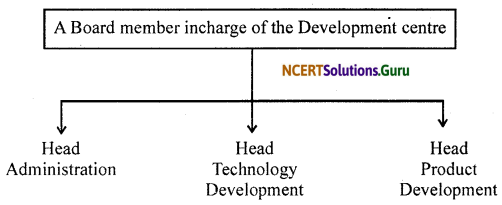
If company will follow this above given structure definately there will be increase in production as well as in income and it will be able to cope up with the present business environment.
Case Problem – 3
A company X limited manufacturing cosmetics, which has enjoyed a pre-eminent position in business, has grown in size. Its business was very good till 1991. But after that, new liberalised environment has seen entry of many MNC’s in the sector. With the result the market share of X limited has declined.
Answer:
The company had followed a very centralised business model with Directors and divisional heads making even minor decisions. Before 1991 this business model had served the company very well as consumers had no choice. But now the company is under pressure to reform.
Question 1.
What organisational structure changes should the ‘ company bring about in order to retain its market share?
Answer:
Instead of Centralization of business activities with the Directors and Divisional Heads even of minor decisions, the management should decentralised the activities to the lower levels of management hierarchy to combat the position of competitors. The organization should also adopt the marketing strategies commonsurate to consumer’s tasks and preferences as required for FMCG (Fast moving consumer goods).
With the liberalization of business environment and entry of MNC’s, the organization should pay attention to consumer satisfaction and ready themselves for product differentation and speciality in the product.

Question 2.
How will the changes suggested by you help the firm? Keep in mind that the sector in which the company is FMCG.
Answer:
The suggestions mentioned in Answer to Question I if implemented in right earnest, the organisation will definetely be benefitted and cope with the competition due to entry of new MNC’s in the field. The tendancy of self-reliance and confidence amongst the subordinates with the help of decentralization definitely help the firm to develop solutions for the problems faced by the competitors. Decisions are taken at levels nearest to the points of action will be beneficial.
![]()
![]()



